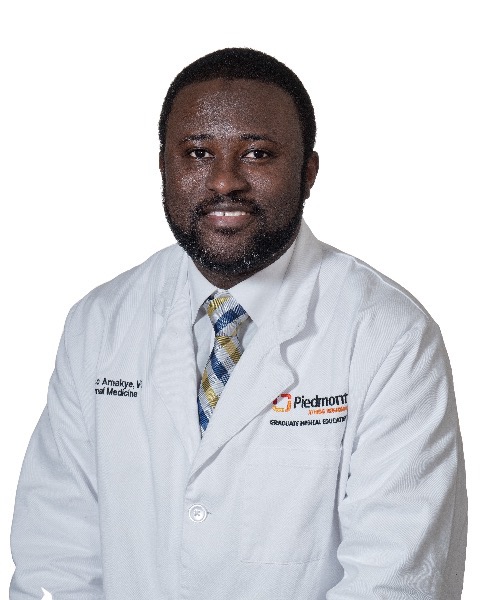Back
Poster Session E - Tuesday Afternoon
E0460 - Rendezvous Endoscopic Recanalization of a Stenosed Esophagus: A Case Report and Review of the Procedure
Tuesday, October 25, 2022
3:00 PM – 5:00 PM ET
Location: Crown Ballroom

Dominic Amakye, MBChB
Piedmont Athens Regional Medical Center
Athens, GA
Presenting Author(s)
Dominic Amakye, MBChB1, Onoriode Kesiena, MBChB MPH1, Ademayowa Ademiluyi, MD1, Kwabena O. Adu-Gyamfi, MBChB2
1Piedmont Athens Regional Medical Center, Athens, GA; 2Medical College of Georgia - Augusta University, Augusta, GA
Introduction: Complete esophageal stenosis is a rare complication of radiotherapy for head and neck cancers. The associated dysphagia severely impacts quality of life even when alternative routes of feeding are established. Different techniques for endoscopic management of complete esophageal stenosis have been described. We report an interesting case of total esophageal obstruction successfully treated with rendezvous endoscopic recanalization.
Case Description/Methods: A 76-year-old male with a history of subglottic squamous cell carcinoma status post chemoradiotherapy with a feeding gastrostomy and tracheostomy tube presented with worsening of his chronic dysphagia, now unable to swallow oral secretions. Esophagogastroduodenoscopy (EGD) a month prior revealed total stenosis of upper third of esophagus. On exam vitals were normal with BMI 20.68 kg/m2. Abdomen was nontender, with a feeding gastrostomy tube in place. Patient was seen by the gastroenterology service and had an EGD with an antegrade-retrograde rendezvous procedure described below.
Procedure
Complete esophageal stenosis was identified at 20cm from incisors. A pediatric gastroscope was advanced through the gastrostomy tube site in a retrograde fashion to the site of obstruction. A Boston scientific stiff wire was probed through the thinnest area which was determined by transillumination and advanced into the pharynx. An adult gastroscope was advanced through the mouth and the wire grabbed with a rat tooth forceps. A guide wire was then threaded through the canalized obstructed segment in an antegrade fashion and then loaded with a CRE balloon. The stenosed segment was balloon-dilated to 9 mm and then stented with a 10 mm x 40mm GORE VIABIL. Images of the procedure are shown in figure 1A to 1C.
Post-op, patient noted return of worsening dysphagia after 48hours. Repeat EGD showed the esophageal stent partially clogged with tissue debris. The stent along with the tissue debris was removed. The area was dilated to 12 mm and re-stented with a GORE VIABIL 10 mm x 80 mm
Discussion: This case illustrates the successful endoscopic treatment of complete esophageal stenosis using anterograde-retrograde rendezvous procedure. Though there are no randomized trials on this approach, it is an effective means of treatment. The success of recanalization depends on features such as location and length of the stenosis. Complications include clogging of stent as seen in our patient but overall safety and success is higher compared to anterograde dilatation only.

Disclosures:
Dominic Amakye, MBChB1, Onoriode Kesiena, MBChB MPH1, Ademayowa Ademiluyi, MD1, Kwabena O. Adu-Gyamfi, MBChB2. E0460 - Rendezvous Endoscopic Recanalization of a Stenosed Esophagus: A Case Report and Review of the Procedure, ACG 2022 Annual Scientific Meeting Abstracts. Charlotte, NC: American College of Gastroenterology.
1Piedmont Athens Regional Medical Center, Athens, GA; 2Medical College of Georgia - Augusta University, Augusta, GA
Introduction: Complete esophageal stenosis is a rare complication of radiotherapy for head and neck cancers. The associated dysphagia severely impacts quality of life even when alternative routes of feeding are established. Different techniques for endoscopic management of complete esophageal stenosis have been described. We report an interesting case of total esophageal obstruction successfully treated with rendezvous endoscopic recanalization.
Case Description/Methods: A 76-year-old male with a history of subglottic squamous cell carcinoma status post chemoradiotherapy with a feeding gastrostomy and tracheostomy tube presented with worsening of his chronic dysphagia, now unable to swallow oral secretions. Esophagogastroduodenoscopy (EGD) a month prior revealed total stenosis of upper third of esophagus. On exam vitals were normal with BMI 20.68 kg/m2. Abdomen was nontender, with a feeding gastrostomy tube in place. Patient was seen by the gastroenterology service and had an EGD with an antegrade-retrograde rendezvous procedure described below.
Procedure
Complete esophageal stenosis was identified at 20cm from incisors. A pediatric gastroscope was advanced through the gastrostomy tube site in a retrograde fashion to the site of obstruction. A Boston scientific stiff wire was probed through the thinnest area which was determined by transillumination and advanced into the pharynx. An adult gastroscope was advanced through the mouth and the wire grabbed with a rat tooth forceps. A guide wire was then threaded through the canalized obstructed segment in an antegrade fashion and then loaded with a CRE balloon. The stenosed segment was balloon-dilated to 9 mm and then stented with a 10 mm x 40mm GORE VIABIL. Images of the procedure are shown in figure 1A to 1C.
Post-op, patient noted return of worsening dysphagia after 48hours. Repeat EGD showed the esophageal stent partially clogged with tissue debris. The stent along with the tissue debris was removed. The area was dilated to 12 mm and re-stented with a GORE VIABIL 10 mm x 80 mm
Discussion: This case illustrates the successful endoscopic treatment of complete esophageal stenosis using anterograde-retrograde rendezvous procedure. Though there are no randomized trials on this approach, it is an effective means of treatment. The success of recanalization depends on features such as location and length of the stenosis. Complications include clogging of stent as seen in our patient but overall safety and success is higher compared to anterograde dilatation only.

Figure: Endoscopic images of procedure
Disclosures:
Dominic Amakye indicated no relevant financial relationships.
Onoriode Kesiena indicated no relevant financial relationships.
Ademayowa Ademiluyi indicated no relevant financial relationships.
Kwabena Adu-Gyamfi indicated no relevant financial relationships.
Dominic Amakye, MBChB1, Onoriode Kesiena, MBChB MPH1, Ademayowa Ademiluyi, MD1, Kwabena O. Adu-Gyamfi, MBChB2. E0460 - Rendezvous Endoscopic Recanalization of a Stenosed Esophagus: A Case Report and Review of the Procedure, ACG 2022 Annual Scientific Meeting Abstracts. Charlotte, NC: American College of Gastroenterology.
